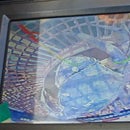Introduction: CrabCam Part Three: the Receiver
The receiving end is a lot simpler than the camera or transmitter: It consists of a wireless switch to turn the camera on, and a receiver to view the video from the camera in the trap. There are two options for this: a stand alone video receiver, or viewing the video on your cell phone or tablet. We'll look at both of these.
Supplies
Receiver:
- Electronic Project Box $ 5.48
- 1 USB Nano V3.0 ATmega168 5V $ 3.92
- 2 pcs mini round tactile momentary push buttons $ 2.99
- 5 X 7 cm DIY Prototype PCB Universal prototyping Board $ 1.63
- 150 pcs (box) JST-XH 2- 3- 4- 5 Pine 2.54mm Terminal Housing PCB Headers $ 3.83
- 120 pcs (box) M3 Nylon Hex Spacer Screw Nut Stand-off plastic accessory kit $ 5.37
- Round Panel Chase Mount Female Socket DC connector Jack plug 5.5mm $ 1.79
- 4.3" Car TFT Digital LCD Monitor $14.38
- OR- FPV Mini 5.8Ghz 150 ch Receiver UVC Video Downlink transmitter $18.71
- 12volt DC female to 3 way male power plug splitter cable $ 1.59
- 12.5 volt 4.5Ah Rechargeable sealed battery $13.36
Step 1: The Camera/Transmitter On/Off Unit
The only part you have to actually build is the camera/transmitter controller. This consists of an arduino mini, a NRF24L01 transmitter, and two momentary push buttons. It's essentially the other half of the relay program covered in the transmitter step. I also connected it to a 12v to 5v step down converter so I could run it from a 12 volt battery (or a 9 v battery as well). I put the whole thing in a project box.
NEXT: the buoy
Step 2: Wiring and Code
Again I owe the programming for the NRF24L01 relay control totally to Danny Vandenbrande whose instructable can be found at:
https://www.instructables.com/id/Arduino-NRF24L01-2...
Again a few notes to consider when using his project. I found it was sensitive to the version of arduino you use as well as VERY sensitive the library. If your getting errors - that's where it will be. For the record I'm using Arduino version:1.8.7 and the following library: Maniac library
Step 3: Wiring Up the Complete Receiver Unit.
The wiring is fairly straight forward. To cut down on the amount of wires I purchased a three way splitter that allowed me to easily share the 12volt output with the controller, monitor and receiver. The only output you need to use from the monitor is the (video). On the unit I had I found I had to change the plug on the video output to easily mate with the output from the receiving unit. Whether you'll need to do that depends on what unit your purchased - or you could use a gender bender. I used a small 12 volt sealed lead acid battery for power, but you could use virtually any 12 volt source.
Step 4: Alternative Receiver Display
...or you could go real simple. You can purchase a FPV Mini 5.8G 150CH Receiver UVC Video for under twenty dollars - about what you'd pay for a small car monitor. It's very simple to use: Just plug it into your cell phone and download a program. I used Easycap & UVC Player(FPViewer), a free program available on google play.
The pros of this is that it's super simple, only one wire, no need for a battery. THe con is that it's heavy on your cell phone battery.











